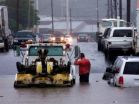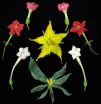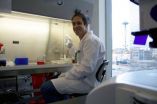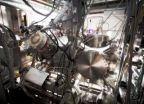(Press-News.org) This press release is available in German.
Using the world's most powerful X-ray laser in California, an international research team discovered a surprising behaviour of atoms: with a single X-ray flash, the group led by Daniel Rolles from the Center for Free-Electron Laser Science (CFEL) in Hamburg (Germany) was able to kick a record number of 36 electrons at once out of a xenon atom. According to theoretical calculations, these are significantly more than should be possible at this energy of the X-ray radiation. The team present their unexpected observations in the journal "Nature Photonics". CFEL is a collaboration of DESY, the Max Planck Society and the University of Hamburg.
When an atom loses electrons, it acquires a positive electric charge – it becomes ionized. This ionization is stronger the more electrons are torn from the atom. The researchers led by Rolles, who is working in the Max Planck Advanced Study Group at CFEL, had fired intense X-ray laser flashes from the Linac Coherent Light Source (LCLS) at the US National Accelerator Laboratory SLAC in California at atoms of the noble gas xenon. With 1.5 kiloelectronvolts (1.5 keV), the particles of light (photons) of the X-ray radiation had around a thousand times more energy than visible light. When such a high-energy photon hits an electron in the xenon atomic shell, its energy is transferred to the electron. Through this collision, the electron can be ejected from the atomic shell – depending on how strongly it is bound.
According to calculations, up to 26 of the 54 electrons of the noble gas could be kicked out at the energy employed, the remaining are too strongly bound. In fact, however, the researchers found that up to 36 electrons flew from the atoms. "To our knowledge, this is the highest ionization that has ever been achieved in an atom using a single electromagnetic pulse," says Rolles, who will lead a Helmholtz Young Investigators group at DESY in the future. "Our observation shows that the existing theoretical approaches have to be modified."
What causes the "impossible" ionization is a so-called resonance: in the energy range used, xenon electrons can absorb a lot of X-ray radiation. Some are thus directly ejected from the atom, while others go into an excited, i.e. more energetic, state, but are still bound to the atom. When one of the excited electrons returns to its initial state, in turn energy is released, which can give another excited electron the necessary extra nudge to kick it out of the atom. In rare cases, the already excited electron is hit by a second photon from the X-ray flash, and so ejected from the atomic shell.
"The LCLS experiment produced an unexpected and unprecedented charge state by ejecting dozens of electrons from an atom," says graduate student and co-author Benedikt Rudek from the Max Planck Advanced Study Group and the Max Planck institute for nuclear physics in Heidelberg, who analysed the data. "The absorbed energy per atom was more than twice as high as expected." This resonance effect is particularly strong for xenon at an energy of 1.5 keV. Consequently, even at a higher energy of 2 keV, the researchers observed only less strongly ionized atoms. Based on the measurements, the CFEL researchers refined a computational model that allows them to calculate such resonances in heavy atoms. In subsequent experiments, scientists used the LCLS to examine, among others, krypton and molecules that contain heavy atoms, as co-author Artem Rudenko from Kansas State University says, who headed one of these follow-up experiments.
The observations also have practical significance for research: "Our results give a recipe for maximizing the loss of electrons in a sample," says Rolles. This can be desirable or undesirable. "For instance, researchers can use our results if they're interested in creating a very highly charged plasma." When investigating biological samples, however, most researchers should avoid the resonance regions of such heavy atoms. "Most biological samples have some heavy atoms embedded," says Rolles. In the resonance region, such samples can be damaged very quickly in these places, which may affect the image quality.
For their precision measurements the team used a special experimental station that was built by the Max Planck Advanced Study Group (ASG) at CFEL together with the Max Planck institutes for nuclear physics, for medical research and semiconductor laboratory. The CFEL-ASG Multi-Purpose chamber (CAMP) was shipped to SLAC in 40 crates weighing a total of 11 tons and was installed at the LCLS for three years. It was used in more than 20 experiments.
Along with researchers from the Center for Free-Electron Laser Science, several Max Planck institutes, DESY and the US National Accelerator Laboratory SLAC, the study involved scientists from about a dozen institutions in Germany, France, Japan and the USA.
###
Reference
Ultra-efficient ionization of heavy atoms by intense X-ray free-electron laser pulses; Daniel Rolles et al.; Nature Photonics, 2012 (advance online publication); DOI: 10.1038/NPHOTON.2012.261
About LCLS
The Linac Coherent Light Source is a Department of Energy Office of Science-funded facility located at SLAC National Accelerator Laboratory. LCLS is the world´s first hard X-ray free-electron laser, allowing researchers to see atomic-scale detail on ultrafast timescales. The LCLS enables groundbreaking research in physics, chemistry, structural biology, energy science and many other diverse fields.
http://lcls.slac.stanford.edu
About CFEL
The Center for Free-Electron Laser Science (CFEL) on the DESY campus in Hamburg is a joint enterprise of Deutsches Elektronen-Synchrotron DESY, the Max Planck Society and the University of Hamburg. CFEL is designed to advance science with so-called free-electron lasers (FELs). These novel light sources based on linear particle accelerators enable to observe nature live on the scale of single molecules and atoms. Leading scientists of various disciplines meet under the CFEL roof to work jointly on interdisciplinary themes.
http://www.cfel.de/index_eng.html
36 in one fell swoop -- researchers observe 'impossible' ionization
World’s most powerful X-ray laser kicks record number of electrons out of an atom
2012-11-12
ELSE PRESS RELEASES FROM THIS DATE:
'Groundwater inundation' doubles previous predictions of flooding with future sea level rise
2012-11-12
Scientists from the University of Hawaii at Manoa (UHM) published a study today in Nature Climate Change showing that besides marine inundation (flooding), low-lying coastal areas may also be vulnerable to "groundwater inundation," a factor largely unrecognized in earlier predictions on the effects of sea level rise (SLR). Previous research has predicted that by the end of the century, sea level may rise 1 meter. Kolja Rotzoll, Postdoctoral Researcher at the UHM Water Resources Research Center and Charles Fletcher, UHM Associate Dean, found that the flooded area in urban ...
Game changer for arthritis and anti-fibrosis drugs
2012-11-12
(SALT LAKE CITY)—In a discovery that can fundamentally change how drugs for arthritis, and potentially many other diseases, are made, University of Utah medical researchers have identified a way to treat inflammation while potentially minimizing a serious side effect of current medications: the increased risk for infection.
These findings provide a new roadmap for making powerful anti-inflammatory medicines that will be safer not only for arthritis patients but also for millions of others with inflammation-associated diseases, such as diabetes, traumatic brain injury, ...
CSHL-led team discovers new way in which plants control flower production
2012-11-12
Cold Spring Harbor, N.Y. – Flowers don't just catch our eyes, they catch those of pollinators like bees as well. They have to, in order to reproduce. Because plants need to maximize the opportunity for pollinators to gain access to their seeds, variations in the timing of flowering can have profound effects on flower, fruit, and seed production, and consequently agricultural yields.
We know that the major driving forces of flowering are external factors such as light and temperature. However, new research from CSHL Assistant Professor Zach Lippman, Ph.D. and his collaborators, ...
Mutations in genes that modify DNA packaging result in Facioscapulohumeral Muscular Dystrophy
2012-11-12
A recent finding by medical geneticists sheds new light on how Facioscapulohumeral Muscular Dystrophy develops and how it might be treated. More commonly known as FSHD, the devastating disease affects both men and women.
FSHD is usually an inherited genetic disorder, yet sometimes appears spontaneously via new mutations in individuals with no family history of the condition.
"People with the condition experience progressive muscle weakness and about 1 in 5 require wheelchair assistance by age 40," said Dr. Daniel G. Miller, University of Washington associate professor ...
Study provides recipe for 'supercharging' atoms with X-ray laser
2012-11-12
Researchers using the Linac Coherent Light Source (LCLS) at the U.S. Department of Energy's (DOE) SLAC National Accelerator Laboratory have found a way to strip most of the electrons from xenon atoms, creating a "supercharged," strongly positive state at energies previously thought too low.
The findings, which defy expectations and theory, could help scientists deliberately induce the high levels of damage needed to study extreme states of matter or ward off damage in samples they're trying to image. The results were reported this week in Nature Photonics.
While the ...
Why Antarctic sea ice cover has increased under the effects of climate change
2012-11-12
The first direct evidence that marked changes to Antarctic sea ice drift have occurred over the last 20 years, in response to changing winds, is published this week in the journal Nature Geoscience. Scientists from NERC's British Antarctic Survey (BAS) and NASA's Jet Propulsion Laboratory (JPL), Pasadena California explain why, unlike the dramatic losses reported in the Arctic, the Antarctic sea ice cover has increased under the effects of climate change.
Maps created by JPL using over 5 million individual daily ice motion measurements captured over a period of 19 years ...
Did wild birds cause the 2010 deadly West Nile virus outbreak in Greece?
2012-11-12
In 2010, 35 people in Greece died from a West Nile virus (WNV) outbreak, with a further 262 laboratory-confirmed human cases. A new article published in BioMedCentral's open access journal Virology Journal examines whether wild or migratory birds could have been responsible for importing and amplifying the deadly virus.
WNV is a flavivirus of major public health concern, spread through the bite of infected mosquitoes. Discovered in Uganda in 1937, it was only sporadically reported up until the 1990s, after which disease outbreaks were reported world-over, leading to ...
Scientists discover new method of gene identification
2012-11-12
Scientists studying the genes and proteins of human cells infected with a common cold virus have identified a new gene identification technique that could increase the genetic information we hold on animals by around 70 to 80 per cent. The findings, published in Nature Methods, could revolutionise our understanding of animal genetics and disease, and improve our knowledge of dangerous viruses such as SARS that jump the species barrier from animals to humans.
Modern advances in genome sequencing — the process of determining the genetic information and variation controlling ...
Cultural dimensions of climate change are underestimated, overlooked and misunderstood
2012-11-12
The impact of climate change on many aspects of cultural life for people all over the world is not being sufficiently accounted for by scientists and policy-makers. University of Exeter-led research by an international team, published on 11th November in Nature Climate Change, shows that cultural factors are key to making climate change real to people and to motivating their responses.
From enjoying beaches or winter sports and visiting iconic natural spaces to using traditional methods of agriculture and construction in our daily lives, the research highlights the cultural ...
Making a better invisibility cloak
2012-11-12
DURHAM, N.C. -- The first functional "cloaking" device reported by Duke University electrical engineers in 2006 worked like a charm, but it wasn't perfect. Now a member of that laboratory has developed a new design that ties up one of the major loose ends from the original device.
These new findings could be important in transforming how light or other waves can be controlled or transmitted. Just as traditional wires gave way to fiber optics, the new meta-material could revolutionize the transmission of light and waves.
Because the goal of this type of research involves ...
LAST 30 PRESS RELEASES:
University of Oklahoma researcher awarded funding to pursue AI-powered material design
Exploring how the visual system recovers following injury
Support for parents with infants at pediatric check-ups leads to better reading and math skills in elementary school
Kids’ behavioral health is a growing share of family health costs
Day & night: Cancer disrupts the brain’s natural rhythm
COVID-19 vaccination significantly reduces risk to pregnant women and baby
The role of vaccination in maternal and perinatal outcomes associated with COVID-19 in pregnancy
Mayo Clinic smartwatch system helps parents shorten and defuse children's severe tantrums early
Behavioral health spending spikes to 40% of all children’s health expenditures, nearly doubling in a decade
Digital cognitive behavioral treatment for generalized anxiety disorder
Expenditures for pediatric behavioral health care over time and estimated family financial burden
Air conditioning in nursing homes and mortality during extreme heat
The Alps to lose a record number of glaciers in the next decade
What makes a good proton conductor?
New science reporting guide published for journalists in Bulgaria
New international study reveals major survival gaps among children with cancer
New science reporting guide published for journalists in Turkey
Scientists develop a smarter mRNA therapy that knows which cells to target
Neuroanatomy-informed brain–machine hybrid intelligence for robust acoustic target detection
Eight SwRI hydrogen projects funded by ENERGYWERX
The Lundquist Institute and its start-up company Vitalex Biosciences Announces Strategic Advancement of Second-Generation fungal Vaccine VXV-01 through Phase 1 Trials under $40 Million Competitive Con
Fine particles in pollution are associated with early signs of autoimmune disease
Review article | Towards a Global Ground-Based Earth Observatory (GGBEO): Leveraging existing systems and networks
Penn and UMich create world’s smallest programmable, autonomous robots
Cleveland researchers launch first major study to address ‘hidden performance killer’ in athletes
To connect across politics, try saying what you oppose
Modulating key interaction prevents virus from entering cells
Project explores barriers to NHS career progression facing international medical graduates
Jeonbuk National University researchers explore the impact of different seasonings on the flavor perception of Doenjang soup
Two Keck Medicine of USC Hospitals named Leapfrog Top Teaching Hospitals
[Press-News.org] 36 in one fell swoop -- researchers observe 'impossible' ionizationWorld’s most powerful X-ray laser kicks record number of electrons out of an atom




